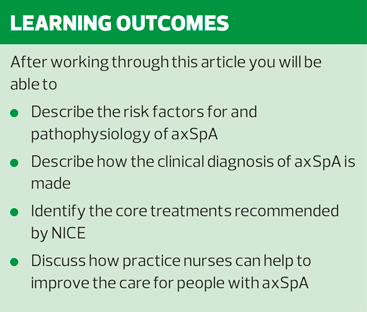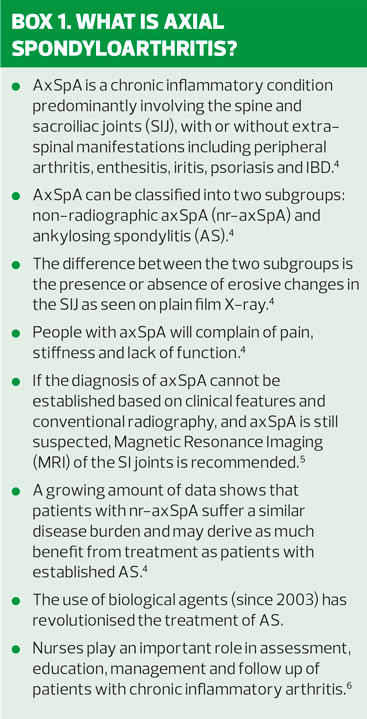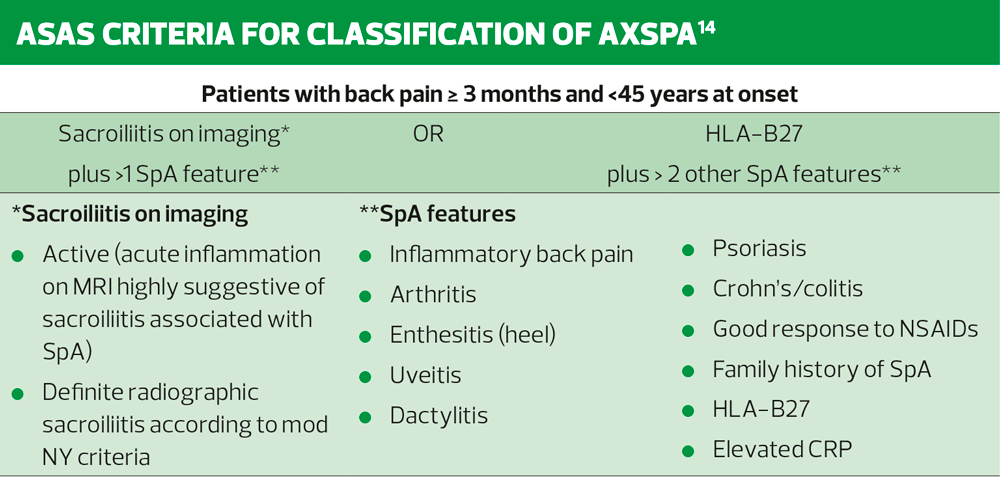Inflammatory arthritis: Part 2 Axial spondyloarthritis
Kate Gadsby
Kate Gadsby
RGN, BSc (hons), Dip MedSci NIP
Honorary Rheumatology Nurse Specialist, Royal Derby Hospital
Tricia Cornell
RGN, BSc (hons), NIP
Honorary Senior Rheumatology Practitioner, Poole Hospital NHS Trust
Declaration of Interest: Both authors work as Rheumatology Nurse Consultants for the pharmaceutical company Abbvie Ltd but hold honorary contracts with the NHS
In the second article in the series on inflammatory arthritis, Practice Nurse presents a step-by-step approach to a case study of axial spondyloarthritis (axSpA) and discuss its assessment, diagnosis and management, and the role of the practice nurse in patient care.
Axial spondyloarthritis (axSpA) is a relatively new umbrella term that encompasses both ankylosing spondylitis (AS) and non-radiographic axial spondyloarthritis (nr-axSpA). AS is where patients have X-ray evidence of sacroiliitis, and nr-axSpA where patients have early axial disease without X-ray changes but with magnetic resonance imaging (MRI) evidence of active inflammation.1 Over a 10-year period, more than half of people with axSpA will progress to radiographic sacroiliitis (AS). The prevalence of ankylosing spondylitis is thought to range from 0.05% to 0.23%, and it is about 3 times more common in men than in women and is predominately seen in the under 40 age group.2,3
CLINICAL FEATURES
The clinical features of axSpA include both spine and extra spinal manifestations. Characteristic symptoms of axSpA are low back pain with prolonged early morning stiffness that improves with exercise; some patients may experience diffuse pelvic pain or sciatica. AxSpA is a painful, progressive form of inflammatory arthritis that affects mainly the sacroiliac joints (SIJ) and spine, but it can also affect other parts of the body including tendons (enthesitis), eyes (uveitis), skin (psoriasis) and bowel (inflammatory bowel disease). Disease damage in AS is progressive and irreversible. While some patients experience mild symptoms and do not seek treatment, others suffer pain and disability which causes increased health care costs and mortality.4
As axSpA is a new term which includes patients with radiographic changes (formerly known as AS) as well as those diagnosed without X-ray changes (for example, using MRI scans) much of the currently available literature focuses on AS. However, there is a consensus among experts that both conditions (nr-axSpA and AS) are part of the same spectrum of disease and so management recommendations apply equally to these patients.7
CASE STUDY – PART 1
Gary is a 21-year-old bricklayer who has been complaining of low back pain radiating down towards both buttocks and the back of his thighs for the past 18 months. He observed that the pain and the stiffness improved with exercise and movement. He is also a keen footballer.
Assessment
The assessment should focus on differentiating between mechanical and inflammatory back pain (IBP). It includes history taking and musculoskeletal examination of the spine. Mechanical back pain, which arises from structural changes that may be in the spinal joints, vertebrae or soft tissues, can be chronic but is usually acute in onset and often self-limiting. Early diagnosis of axSpA is crucial in order for patients to access appropriate treatment to ensure successful lifelong management of this condition.8 There is often a significant delay between patients presenting to their GP with back or joint pain and the diagnosis of AS being made.9 Chronic back pain is a common symptom of patients presenting to primary care, and it is difficult to be precise about the prevalence of IBP due to axSpA in primary care but one study reported a prevalence of 5% among patients with chronic back pain.10,11
IBP is a typical clinical symptom of axSpA including AS.12
According to the Assessment of Spondylitis International Assessment Society (ASAS) criteria, a diagnosis of IBP requires the presence of 4 out of 5 of the following features:
1. Age at onset
2. Insidious onset
3. Improvement with exercise
4. No improvement with rest
5. Pain at night (with improvement upon getting up).12
Clinical examination
Clinical examination in a rheumatology department should include measurement of forward lumbar flexion (Schober’s test, > 5 cm flexion is normal), lateral lumbar flexion, and chest expansion, as well as stressing the sacroiliac joints.13 The peripheral joints should also be examined for evidence of synovitis or enthesitis (inflammation of entheses, the sites where tendons and ligaments attach to bone). There can be significant extra-spinal involvement and patients should be assessed for the presence of anterior uveitis (which occurs in up to 40% of patients), aortic incompetence, cardiac conduction disturbances, and pulmonary fibrosis. Not every patient will have all clinical features present at onset and, if present, they may be subtle in mild cases.13
Investigations and diagnosis
Investigations in axSpA include imaging (X-rays, MRI), blood tests which include inflammatory markers and a genetic marker, HLA-B27. The inflammatory markers may be raised, but this is not always the case and may relate to disease activity in peripheral joints rather than axial disease activity.13
The diagnosis is based mainly on clinical features according to ASAS criteria, which include MRI to detect active inflammation and establish an early diagnosis.12 (Box 2)
Differential diagnoses
Other diagnoses to consider are psoriatic arthritis, reactive arthritis and enteropathic arthritis associated with inflammatory bowel disease.15
Associated conditions/comorbidities
Extra-spinal manifestations can be frequent in AS and axSpA, and include peripheral arthritis, enthesitis, acute anterior uveitis, psoriasis and inflammatory bowel disease. They are a challenge to manage and require cooperation between specialities in secondary care. There are also frequent comorbidities that require careful management: these include low bone mineral density, osteoporotic fractures and cardiovascular disease, all of which have been noted at a higher incidence in these patients compared with the general population.4
The role of the practice nurse
Gary is referred to the local rheumatology department. While awaiting his referral, he is prescribed analgesia and advised to take a non-steroidal anti-inflammatory drug (NSAID) such as ibuprofen or naproxen. A proton pump inhibitor (PPI) should be prescribed as gastro-protection in patients at high risk of gastrointestinal (GI) adverse effects or to those unable to tolerate NSAIDs due to the GI adverse effects. For those patients in whom NSAIDs are contraindicated, paracetamol with or without codeine can be prescribed.10
At this stage, the practice nurse should advise Gary on lifestyle modifications, for example, maintaining a healthy weight, smoking cessation (if applicable) and the importance of keeping active by exercising or swimming every day, as well as monitoring concordance with NSAIDs.12
CASE STUDY – PART 2
Six months later, Gary returns to your surgery. He has persistent inflammatory back pain and his MRI scan showed sacroiliitis, and the rheumatology department has confirmed a diagnosis of axSpA. He is currently managed conservatively with NSAIDs and physiotherapy. He is complaining of thoracic back pain, tiredness and difficulties doing his job as he is not sleeping well due to back and heel pain during the night. Gary has had previous episodes of painful red eyes diagnosed as uveitis by the ophthalmology on call doctor when he attended A&E.
Management
The aim of management is to provide symptom relief and maintain or improve spinal mobility.9 Evidence-based recommendations for the management of axial SpA include:
- Drug treatment including NSAIDs, corticosteroids and tumour necrosis factor (TNF) inhibitors
- Physiotherapy4
Patients should be offered advice on self-help and daily living, such as exercise, diet and nutrition, pain management and sleep, and maintenance of work.16
Shared-care
Patients who develop extra-articular manifestations and co-morbidities such as uveitis, inflammatory bowel disease, psoriasis, heart or lung problems should be managed in collaboration with specialists.4 It is important for the practice nurse to communicate with the GP and the rheumatology department about Gary’s condition and to encourage him to complete any self-assessment questionnaires about his disease if prompted to do so by the rheumatology department. This will usually take the form of the Bath Ankylosing Spondylitis Activity Index (BASDAI) questionnaire, which is used to assess disease activity and enable patients to access further treatment if needed.9
The BASDAI is the most widely used measure of the inflammatory activity of AS. The BASDAI is a validated, composite index that records patients’ responses to six questions relating to the five major symptoms of AS: fatigue, axial pain, peripheral pain, stiffness and enthesopathy. Responses are recorded on 10 cm visual analogue scales (VAS). The score can range from 0 to 10 but a score of over 4 is regarded as ‘severe disease activity’.3
Physiotherapy
Physiotherapy is a key element in the overall management of all axSpA patients. A Cochrane review found evidence that physiotherapy had beneficial impacts on pain, stiffness, physical function and patient global assessment.17
The National Ankylosing Spondylitis Society (NASS) provides exercise resources for nurses, patients and other health care professionals such as the Back to Action guide (available as an app), online videos and an exercise DVD.18
The role of the practice nurse
Gary is invited to complete a BASDAI online by the rheumatology department which the practice nurse explains is to monitor disease activity. The role of the practice nurse is to encourage completion of the BASDAI and to help the patient understand the importance of monitoring his disease.
Gary is offered a change of NSAID to be taken at full daily dose and is referred by his GP to a podiatrist for the heel pain with a possible diagnosis of plantar fasciitis. The nurse advises him to continue with his daily exercises and physiotherapy for his posture, have a healthy diet and stop smoking. She suggests to Gary that if his symptoms do not improve with the new NSAID that he contacts the rheumatology department advice line and ask for his appointment to be brought forward.
CASE STUDY – PART 3
Gary presents for his expedited rheumatology appointment, his BASDAIs have remained high at 5, which shows active disease. His condition has not improved despite taking maximum dose of his second NSAID. He is finding work very difficult and has been missing playing football even though he has been using the insoles recommended by the podiatrist in his boots at work, and away from work he is wearing trainers to ease the heel pain. The rheumatologist recommends commencing an anti-TNF drug for treatment of his axSpa.
Anti-TNF inhibitors and biologic therapy
According to the NICE guidelines, adult patients with severe active AS are eligible for treatment with adalimumab, certolizumab pegol, etanercept, golimumab or infliximab if their disease has responded inadequately to, or cannot tolerate, NSAIDs.
Adalimumab, certolizumab pegol and etanercept are also recommended as options for treating severe non-radiographic (nr)-axSpA in adults whose disease has responded inadequately to, or who cannot tolerate, NSAIDs.3
Secukinumab is recommended, within its marketing authorisation, as an option for treating active ankylosing spondylitis in adults whose disease has responded inadequately to conventional therapy (NSAIDs or TNFalpha inhibitors).19
Response to treatment
The response to adalimumab, certolizumab pegol, etanercept, golimumab or infliximab treatment should be assessed 12 weeks after the start of treatment and response to secukinumab should be assessed at 16 weeks after commencement of treatment. Treatment should only be continued if there is clear evidence of response, defined as:
- A reduction in the BASDAI score to 50% of the pretreatment value, or by 2 or more units, and
- A reduction in the spinal pain visual analogue scale (VAS) by 2 cm or more.3,19
The role of practice nurse
One year later, Gary returns for his review at the surgery. He is on an anti-TNF agent and has continued with his physiotherapy and exercises as well as analgesia for symptom relief.
The practice nurse should continue to monitor and screen Gary for adverse events associated with TNF inhibitors such as infections. The nurse should also provide advice and education on self-management, and further appraisals – for example, self assessment tests – as well as advice on stopping treatment in case of any surgery (or for female patients, should they become pregnant) depending on the SPC of the specific TNF inhibitor. The nurse should provide advice on flu immunisation in accordance with DH guidelines of chronic disease, and continue to liaise with other members of the multidisciplinary team including Gary’s rheumatologist and his GP.
CONCLUSION
AxSpA is a progressive inflammatory arthritis with historical long delays to diagnosis. Treatment with TNF inhibitors have revolutionised the management of AS. General practice nurses are ideally placed to educate patients about the management of axSpA with NSAIDs, exercise, physiotherapy and TNF inhibitors to keep patients active and in work.
REFERENCES
1. Rudwaleit M, Sieper J. Referral strategies for early diagnosis of axial spondyloarthritis. Nat Rev Rheumatol 2012;8:262-8
2. Kain T, Zochling J, Taylor A, et al Evidence-based recommendations for the diagnosis of ankylosing spondylitis: results from the Australian 3E initiative in rheumatology. MJA 2008;188:235–237
3. NICE TA383. TNF-alpha inhibitors for ankylosing spondylitis and non-radiographic axial spondyloarthritis, 2016 https://www.nice.org.uk/guidance/ta383
4. British Society of Rheumatology BSR and BHPR guideline for the treatment of axial spondyloarthritis (including ankylosing spondylitis) with biologics 2016 doi:10.1093/rheumatology/kew223
5. Mandl P, Narro-Compán V, Terslev L, et al. EULAR recommendations for the use of imaging in the diagnosis and management of spondyloarthritis in clinical practice. Ann Rheum Dis 2015; doi:10.1136/annrheumdis-2014-206971
6. van Eijk-Hustings Y, van Tubergen A, Carina Boström C, et al. EULAR recommendations for the role of the nurse in the management of chronic inflammatory arthritis. Ann Rheum Dis 2012;71:13–19.
7. Braun J, van den Berg R, Baraliakos X, et al. 2010 update of the ASAS/EULAR recommendations for the management of ankylosing spondylitis. 2011 Ann Rheum Dis 70(6): 896-904
8. National Ankylosing Spondylitis Society (NASS). Looking Ahead: best practice for the care of people with ankylosing spondylitis, 2010. http://nass.co.uk/campaigning/looking-ahead/
9. Braun A, Saracbasi E, Grifka J, et al. Identifying patients with axial spondyloarthritis in primary care: how useful are items indicative of inflammatory back pain? Ann Rheum Dis 2011;70(10):1782-7
10. Deyo RA, Mirza SK, Martin BI. Back pain prevalence and visit rates: estimates from U.S. national surveys, 2002. Spine 2006;31:2724–7
11. O’Shea FD, Boyle E, Salonen DC, et al. Inflammatory and degenerative sacroiliac joint disease in a primary back pain cohort. Arthritis Care Res (Hoboken) 2010; 62:447–54
12. Sieper J, van der Heijde D, Landewé R, et al. New criteria for inflammatory back pain in patients with chronic back pain: a real patient exercise by experts from the Assessment of SpondyloArthritis International Society (ASAS). Ann Rheum Dis 2009;68(6):784-8. http://ard.bmj.com/content/68/6/777.full
13. McVeigh C, Cairns A. Diagnosis and management of ankylosing spondylitis, BMJ 2006;333:581-585
14. Rudwaleit M, Landewé R, van der Helde D, et al The development of Assessment of SpondyloArthritis international society classification criteria for axial spondlyoarthritis (part II): validation and final selection. Ann Rheum Dis 2009;66(6):770-776 http://ard.bmj.com/content/68/6/770.full
15. McKenna F. Spondyloarthritis. Hands on Spring 2010;6(5). http://www.arthritisresearchuk.org/health-professionals-and-students/reports/hands-on/hands-on-spring-2010.aspx
16. Arthritis Research UK. Ankylosing spondylitis and related conditions, 2015. https://www.arthritisresearchuk.org
17. Dagfinrud H, et al. Physiotherapy interventions for ankylosing spondylitis. Cochrane Database Syst Rev 2008;(1):CD002822
18. National Ankylosing Spondylitis Society (NASS) Exercises for your AS. http://nass.co.uk/nass/en/exercise/exercise-for-your-as/
19. NICE TA407. Secukinumab for active ankylosing spondylitis after treatment with non-steroidal anti-inflammatory drugs or TNF-alpha inhibitors, 2016 https://www.nice.org.uk/guidance/ta407
Related articles
View all Articles



